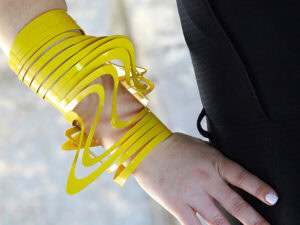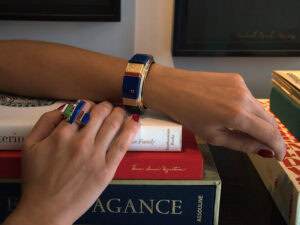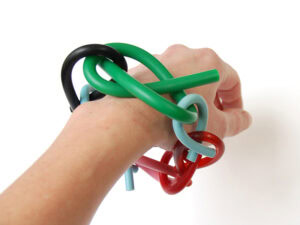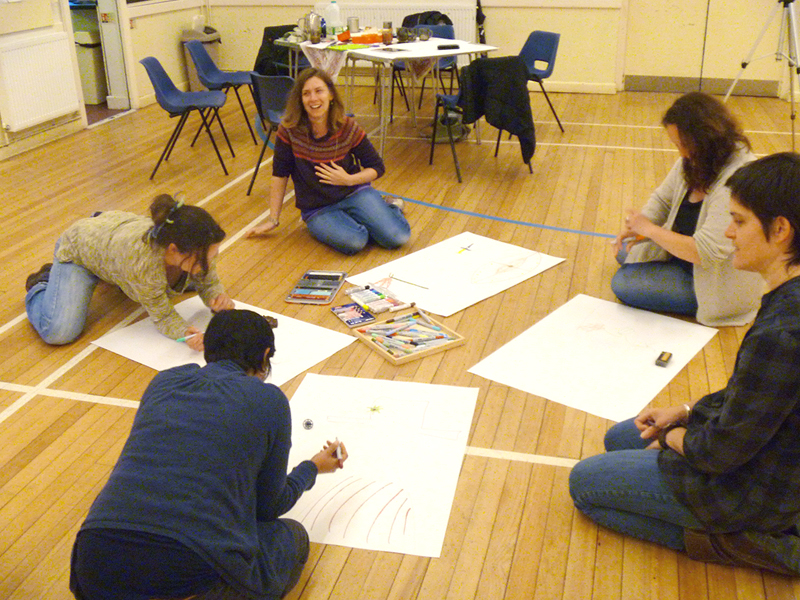
Every once in a while, I receive an essay or a post that provides some insight into how people not “native” to contemporary jewelry might see it: what use that have for it, and what it can do to them. Siân Hindle, a doctoral candidate at Birmingham City University, made contact with me in April 2016, asking whether we would consider publishing a post she’d written. The post described a workshop she organized, and hinted at very exciting findings about just how liberating the experience of contemporary jewelry might be, as compared to more normative forms of adornments. The reaction from workshop participants in fact belies the assumption that contemporary jewelry practice is understandable or accessible only to initiates, and made me want to read Siân’s extended workshop analysis. That will be only published in a couple of years. In the meantime, she very kindly agreed to rewrite her post for AJF, and to share a preview of her research with us.
—Benjamin Lignel
Art jewelry can be tough to wear, so what can we tell from women’s experiences of trying it on and responding to it creatively? During a workshop called Strange Pleasures (held in Birmingham, UK, in May 2014), I invited a group of four women to tell the stories associated with the jewelry that they wore frequently, and to try on and explore a number of pieces of art jewelry that was entirely new to them. I also asked them to respond creatively, making images—both drawings and photographs—that captured something of the experience of wearing both kinds of jewelry.
The jewelry that the participants wore regularly served to lock them in place within their networks of family and friends. All the pieces they brought with them had been given to them by family, husbands, and friends, and wearing them reminded the women of those individuals, as if they were carrying their husband, say, around with them on their finger. One of the women, Jude, started the discussion with a comment about her wedding ring, “which my husband had the cheek to barter down from 4 quid to 3 pound” (Jude)[1], and this narrative got the stories flowing. In general, the participants’ own traditional-precious jewelry was small and required little conscious attention from the wearer, evoking Gijs Bakker’s comment, that “the daily kind of jewellery […] is just something that you forget is even there because it becomes part of your daily habit of dressing.”[2]
A case in point, Jude chose to photograph a pendant given to her by a friend, and captured an image of her head and shoulders that included no clothes; the pendant was worn constantly and, with it, she felt sensorily complete. It is when it was taken off that she felt different, and suddenly aware of her embodied form: “it just makes me feel nak-naked without it” (Jude). Absorbed into habit, it is easily forgotten, and these habits provide us with what sociologist Anthony Giddens (in Modernity and Self-Identity, 1991) calls “ontological security,” the sense that we can go on in the face of sometimes overwhelming doubt. Sensing the reassuring presence of the pendant, Jude can carry on with life, expending only residual mental energy on thoughts of her wider social group. Of course, much of the time this is reassuring, but there is a danger that the interdependence it carries with it becomes suffocating, as if the balance has shifted and the wearer feels she exists for others rather than for herself. In contrast to Jude, Katie had mixed feelings about her jewelry: Her ring was too big and her bracelet was held together with a homemade repair. Since it once belonged to a family friend who took her own life, she was caught in a bind—unable to wear the pieces, and yet unable to relinquish them, either—the indebtedness of the gift seemed to be tempering her enjoyment of the pieces. She was left with jewelry that was, to some degree, burdensome.
The second half of the session was spent exploring, trying on, and responding to a range of pieces of art jewelry, loaned by colleagues at the School of Jewellery, Birmingham City University. The concept of art jewelry was framed as jewelry that often seeks to challenge expectations, being made of unusual materials or worn on parts of the body not usually adorned. Some (albeit limited) information about specific pieces was provided, not least because of the need to alert the women to the fact that two pieces were made of dried meat, which some participants might have been uncomfortable handling. The participants’ responses to the art jewelry were very different as, without the backstory of the traditional-precious jewelry, it provided an occasion for play: The women tried the art jewelry on and experimented with it as children might play with a box of dressing-up clothes, trying on and exploring different identities and versions of themselves.

Katie, in particular, embraced this experience. She tried on a neckpiece by Toni Mayner titled Lost and Found, which featured a rust-encrusted U-bolt and steel micro cable bound with thread, and said that it made her feel “tribal” (Katie). Drawing and photography were used to document the women’s responses: A silhouette was cast by shining a light at each woman wearing the piece she had selected and this was drawn around in pencil; the women were then asked to annotate this with words and drawn images. Later, participants were asked to direct the researcher taking a photograph of them wearing the piece. Katie’s silhouette drawing is annotated with a feather headdress, a shield, and a weapon in the form of a knife, but—taking this idea further and getting more fully into character—she was photographed with felt-tip “war paint” (Katie) on her face. As the women played, they pulled and teased at the embodied conventions that they were usually subject to, and in doing so they began to embrace new ways of thinking of themselves as embodied beings. Instead of being wrapped in the (sometimes suffocating) ontological security provided by their traditional-precious jewelry, the art jewelry caused the wearers to reflect on the version of the self they projected to the world.
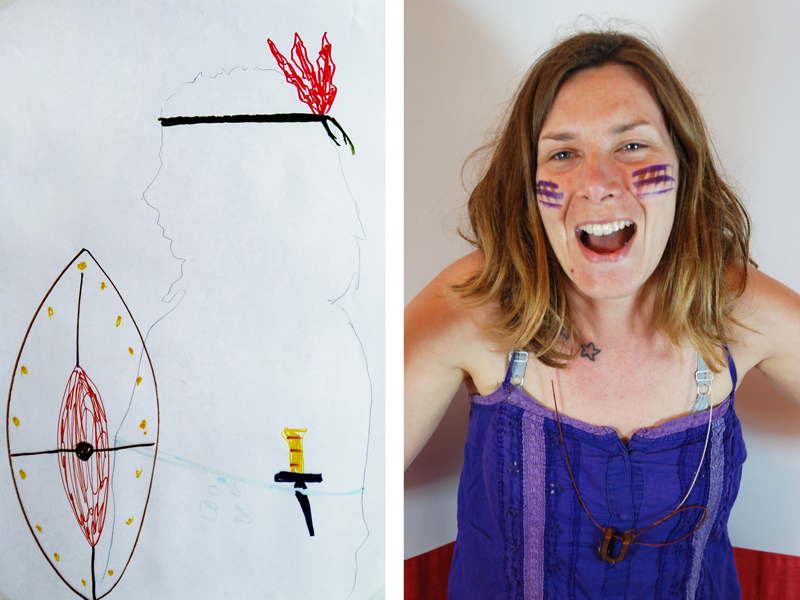
Ambivalence was a key feature of the women’s responses. One of the women, Sally, selected a brooch made of dried, hardened meat shaped into the form of a Tudor rose—Doggy Dodger, by Rachael Colley—and she experienced (and drew) what she described as “that weird attraction/revulsion thing” (Sally). She acknowledged that she found other pieces more visually appealing, but she was clearly intrigued by the material from which Colley’s brooch is made. She felt that the strange appeal of the material was at odds with her stated vegetarianism, and her drawing shows jagged, zigzagging lines in contrasting colors around the lips and mouth of her silhouette. This brought the other women into a conversation about food, and the ensuing discussion danced around the line of prohibition demarcating the foods that, for them, could and could not be eaten: three of the four women commented that they were or had been vegetarian, and yet they traded opinions about the taste of black pudding (a sausage made from pig’s blood), suggesting a kind of teasing play with their own principles. Memories were shared, and curiosity, repulsion, and profound ambivalence were evident. They went on to recall moments when their embodied style, their way of occupying their own bodies, was challenged—during the difficult changes of adolescence, or during pregnancy—suggesting that they felt some empathy with Sally’s ambivalent feelings about the brooch. Here, the women seemed to be rallying around to support Sally to construct an embodied performance—a means of interfacing with the world through her physical form, in ways that both conform to and challenge social mores and behaviors—that helped her make sense of these conflicted feelings.
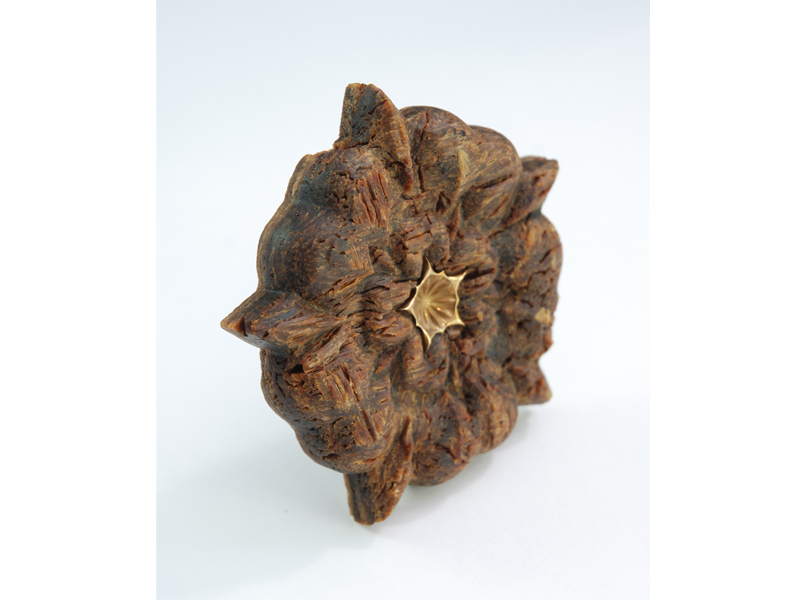
Makers and wearers of art jewelry are familiar with the challenge that the genre offers to the hierarchies of preciousness. On the one hand, the so-called noble metal of gold is often made deliberately ugly (as in Lauren Kalman’s Hard Wear adornments, some of which look like lip sores or nasal mucus); on the other, rubbish is elevated in status and rendered precious through the artistry of the maker (epitomized, perhaps most provocatively, by Lisa Walker’s brooch—Untitled—made from the sweepings from her studio floor). The responses of the women, in contrast, seemed to suggest a challenge of an even more fundamental kind, implying that the line dividing what is human and what is animal is similarly mutable. Within their conversation, the slippage from talk of meat to the puppy fat of adolescence to the weight gain of pregnancy foregrounds the commonalities between animal and human flesh, and this is highlighted by Sally’s observation about the tactile experience of touching the beef: “once I’d picked it up, I sort of regretted it slightly cos it was a bit sticky! I became aware of that, actually, the more I held it, the warmer I made it, the stickier it got!” (Sally). While it is clearly the warmth of Sally’s body that renders the beef sticky, it is also possible to imagine that the brooch itself is coming to life, further contributing to the impression that hierarchies are failing and order is slipping.
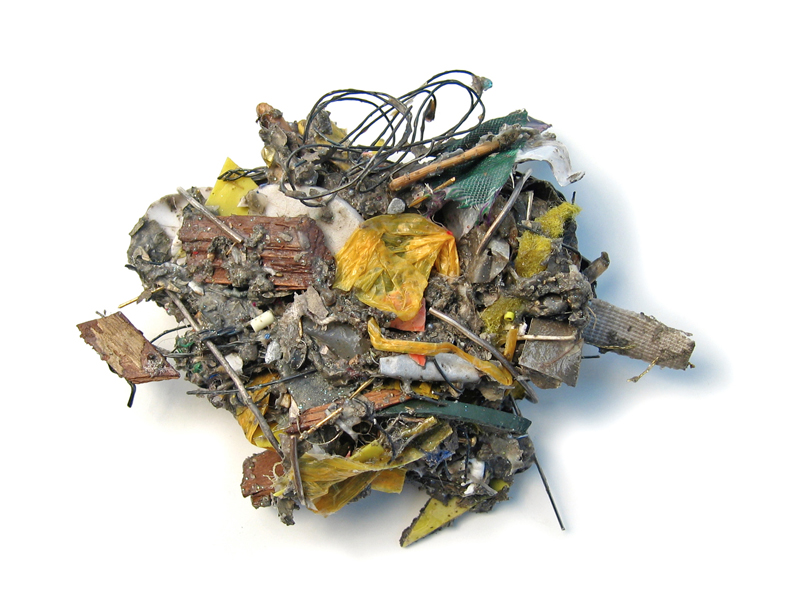
Here, the selection, wearing, and discussion of art jewelry created a moment in which the women’s interactions shifted: A space was opened up, the unstructured nature of which was ripe for play, and the women responded by exploring a range of embodied performances. As a group they seemed to engage enthusiastically with Giddens’s question, “What to do, how to act, who to be?”[3]: Sally, certainly, held her audience’s attention and seemed to enjoy playing for laughs alongside Doggy Dodger; stage make-up (in the form of war paint) was used to complete Katie’s look. By the end of the session, however, the need to present a convincing narrative crept upon the women and they looked for ways to foreground the sense of continuity that underpins the self (particularly in the West); the provisional identities with which they had been playing were abandoned as they returned, at the end of the workshop, to their day-to-day roles.
Within the full article,[4] the framework of leisure provides an opportunity to consider two sides of the jewelry-wearing experience: The women’s traditional-precious jewelry is experienced largely in terms of a social system that controls their behavior; in contrast, the art jewelry points to how wearing adornments is experienced as freedom or play. Of course, the distinction is rarely as cut and dry as experienced in the conditions created in the workshop, but examining them in this way points to the rich range of meanings that jewelry accrues through wear. The article—“On Performing Art Jewellery: Identity Play as Leisure Activity”—will be published in the Dress Issue (part two) of the Annals of Leisure Research (July/August 2016), guest edited by Prof. Alison Goodrum.
[1] All quotes followed by a name in parentheses are from the workshop held in Birmingham, May 2014. The participants’ names have been changed.
[2] Roberta Bernabei, Contemporary Jewellers: Interviews with European Artists (London: Berg, 2011), 59.
[3] Anthony Giddens, Modernity and Self-Identity: Self and Society in the Late Modern Age (Cambridge: Polity Press, 1991), 70.
[4] A full copy of the article can be found at Siân’s blog: https://sianhindle.wordpress.com
The article’s co-authors, Rachael Colley and Dr. Anne Boultwood, are also researchers at Birmingham City University: Colley is a lecturer at the School of Jewellery and Dr. Boultwood is Reader in the Psychology of Fashion.


